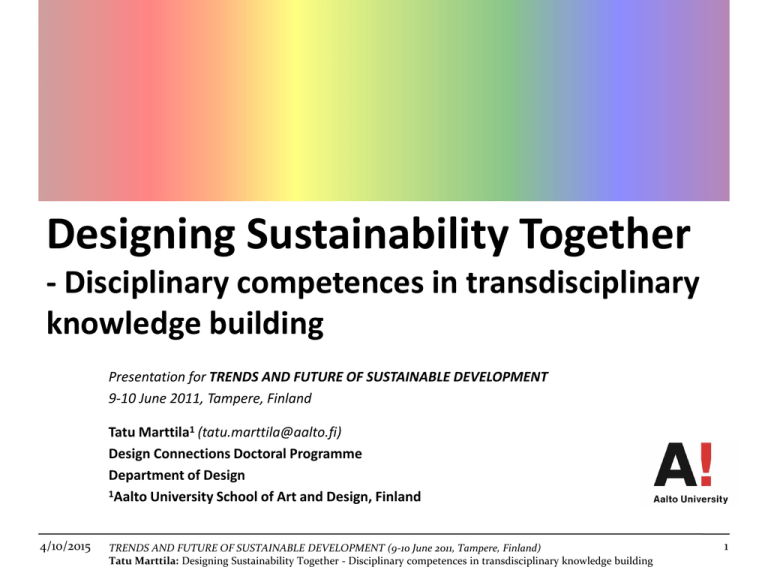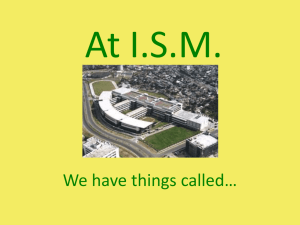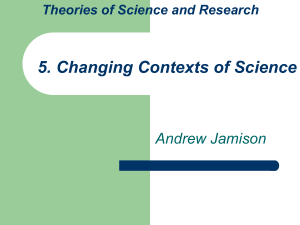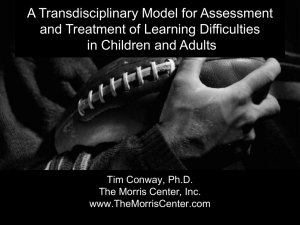Disciplinary Competences in Transdisciplinary Knowledge Building
advertisement

Designing Sustainability Together - Disciplinary competences in transdisciplinary knowledge building Presentation for TRENDS AND FUTURE OF SUSTAINABLE DEVELOPMENT 9-10 June 2011, Tampere, Finland Tatu Marttila1 (tatu.marttila@aalto.fi) Design Connections Doctoral Programme Department of Design 1Aalto University School of Art and Design, Finland 4/10/2015 TRENDS AND FUTURE OF SUSTAINABLE DEVELOPMENT (9-10 June 2011, Tampere, Finland) Tatu Marttila: Designing Sustainability Together - Disciplinary competences in transdisciplinary knowledge building 1 Introduction and Background 4/10/2015 TRENDS AND FUTURE OF SUSTAINABLE DEVELOPMENT (9-10 June 2011, Tampere, Finland) Tatu Marttila: Designing Sustainability Together - Disciplinary competences in transdisciplinary knowledge building 2 Aim of this paper… Sustainability can be generally understood as an approach to design and development "that focuses on environmental, social, and financial factors" and is about "balancing" and "mediation" between different ideas and concepts (Shedroff 2009, 5). It requires insight from several professions, and systemic understanding on stakeholders and their interests. Transdisciplinarity has become "a label for collaborative research" in sustainable design, crossing over disciplinary boundaries and sectors of society (Bruun et al 2005), and gradually deepening the integration in communication and knowledge between the participants (Hukkinen 2008). This text explores previous research on transdisciplinarity, and new data that is gathered with questionnaires from a multidisciplinary Master's study programme. It is positioning further research and development in design teamwork between multiple disciplines, and it aims to identify the necessary approaches to collaborative and transdisciplinary knowledge building for sustainability. 4/10/2015 TRENDS AND FUTURE OF SUSTAINABLE DEVELOPMENT (9-10 June 2011, Tampere, Finland) Tatu Marttila: Designing Sustainability Together - Disciplinary competences in transdisciplinary knowledge building 3 Theory and Literature 4/10/2015 TRENDS AND FUTURE OF SUSTAINABLE DEVELOPMENT (9-10 June 2011, Tampere, Finland) Tatu Marttila: Designing Sustainability Together - Disciplinary competences in transdisciplinary knowledge building 4 Balancing sustainability Sustainable design should focus on the three different dimensions of sustainable development: ecological, economic and sociocultural aspects. These dimensions can be perceived to interact equally, or then hierarchically (see Fig. 1). The traditional triangular model, however, may lead into "a narrow techno-scientific approach" (Gidding et al. 2002, 187). In hierarchial or "nested" model for sustainable development the "economy is dependent on society and both dependent on the environment" (Ibid., 192). The nested approach helps to prioritize the compromises that have to be made. To follow the systemic approach, a team should first consult their shared idea of the task, then both socio-economic (stakeholders) and ecological systems (ecological feasibility), and then adjust the concept according to these. 4/10/2015 Figure 1. The triangular versus the "nested" model for sustainable development (Source: Gidding et al. 2002) TRENDS AND FUTURE OF SUSTAINABLE DEVELOPMENT (9-10 June 2011, Tampere, Finland) Tatu Marttila: Designing Sustainability Together - Disciplinary competences in transdisciplinary knowledge building 5 The need for transdisciplinarity "Wicked" problems require "integrated and flexible design solutions" that are adapted to the "eco-social complexity of their scale-linking context" (Wahl & Baxter 2008, 75). In a complex system "collective and inclusive decision-making" helps to develop more sustainable solutions, as it is "informed by a broader knowledge base" (Ibid., 76). The processes of collaborative work between professionals from different fields range from cross- or multidisciplinary to interdisciplinary and eventually to transdisciplinary, gradually deepening the integration of knowledge, communication and values between the participants and the society (Hukkinen, 2008; Bruun et al, 2005). At the same time the abilities to translate and analyze disciplinary frameworks and concepts become important, because without a mutual understanding and agreement on visions, scenarios and problem-setting true progress cannot be made (see e.g. Marttila and Kohtala 2010). 4/10/2015 TRENDS AND FUTURE OF SUSTAINABLE DEVELOPMENT (9-10 June 2011, Tampere, Finland) Tatu Marttila: Designing Sustainability Together - Disciplinary competences in transdisciplinary knowledge building 6 Merging the professional knowledge In the merging of transdisciplinary knowledge the aim in the process is in acquiring an “integral vision” to understand and weave together different perspectives and worldviews (Wilber 2001; as in Wahl & Baxter 2008). The merged outcome resembles "Mode 2" knowledge (Gibbons et al. 1994), which is socially distributed, application-oriented and transdisciplinary (Nowotny et al. 2003, 179). This new type of knowledge requires unconstrained and instantaneous interaction, and is "highly reflexive" (Nowotny et al. 2003, 187). It also requires iterative approach, such as “Spiral Dynamics” that emerges from details towards the holistic system level, and is emphasizing both professional side and the shared side of the process (Beck & Cowan 1996; as in Wahl & Baxter 2008, 76). Also, in parallel with the iterative co-creation of the design aim on several scales and perspectives, there should be also a professional loop, in which the focus is on specialist and profession-specific tools. 4/10/2015 TRENDS AND FUTURE OF SUSTAINABLE DEVELOPMENT (9-10 June 2011, Tampere, Finland) Tatu Marttila: Designing Sustainability Together - Disciplinary competences in transdisciplinary knowledge building 7 Metadesigning collaborative frameworks This integration of knowledge through iterative process happens on the "metadesign" level that focuses on "conscious awareness, value systems, worldviews, and aspirations" (Wahl & Baxter 2008, 73) and reflexive processes that build “value-consciousness” among researchers are required (Wiesmann et al. 2008, 438). Transdiciplinary design process is aiming into higher contextual level: on mediation between value systems and visions, and the process itself. There should exist a collaborative framework to design process, which would promote the merging of knowledge, value systems and design aims, and support integration, expanding on solution level from details to the whole, and on value level from the whole towards the details. While the emphasis for multiprofessional collaboration has to be on the professional skills and expertise, in sustainable design the complex problems always require also a transdisciplinary approach. This calls for a problem assessment process that is done iteratively, integrally and within a shared problem space, but with predefined disciplinary competences. 4/10/2015 TRENDS AND FUTURE OF SUSTAINABLE DEVELOPMENT (9-10 June 2011, Tampere, Finland) Tatu Marttila: Designing Sustainability Together - Disciplinary competences in transdisciplinary knowledge building 8 Material and Methods 4/10/2015 TRENDS AND FUTURE OF SUSTAINABLE DEVELOPMENT (9-10 June 2011, Tampere, Finland) Tatu Marttila: Designing Sustainability Together - Disciplinary competences in transdisciplinary knowledge building 9 Research data Research data is gathered with questionnaires from the students of a new multidisciplinary Masters' programme in Aalto University called Creative Sustainability (CS), which started recently in Fall 2010. During the academic year (2010-2011) these students attended introduction courses that aimed to prepare them for multi-professional collaboration, and then to complete modules (up to 15 ECTS), which were engaging several professions, and which involved the multidisciplinary student teams in specific design cases. The data is gathered from the students of two study-modules, of which the other was organized in Fall 2010 by the Department of Design with 14 answerers, and the other during Spring 2011 by the Department of Architecture with also 14 answerers. Courses had students with backgrounds in various design fields, such as industrial (7), product (2), spatial (2) and graphic design (2), engineering (2), architecture (6), real estate (2), economics (2) and media communication (1). Both courses were credited with 15 ECTS, and they included lectures and a design case. 4/10/2015 TRENDS AND FUTURE OF SUSTAINABLE DEVELOPMENT (9-10 June 2011, Tampere, Finland) Tatu Marttila: Designing Sustainability Together - Disciplinary competences in transdisciplinary knowledge building 10 Student questionnaire The student questionnaire was created based on the findings in the literature study, and on earlier research. The part of the questionnaire in focus in this article consisted of triangular rating regarding the balances between the dimensions of sustainability, and the emphases in multi-professional collaboration (see Fig. 2). The results were assessed to visually compare where the emphases are, and how shattered the outcome was. These findings were then reflected on the earlier findings from the theory and literature. Figure 2. The student questionnaire and the triangles. 4/10/2015 TRENDS AND FUTURE OF SUSTAINABLE DEVELOPMENT (9-10 June 2011, Tampere, Finland) Tatu Marttila: Designing Sustainability Together - Disciplinary competences in transdisciplinary knowledge building 11 Findings from the data 4/10/2015 TRENDS AND FUTURE OF SUSTAINABLE DEVELOPMENT (9-10 June 2011, Tampere, Finland) Tatu Marttila: Designing Sustainability Together - Disciplinary competences in transdisciplinary knowledge building 12 Analyzing the results Transdisciplinary collaboration should be based on integrated value systems and new application-oriented knowledge. It is justified to assume that in sustainable design shared understanding of the problem should be perceived beneficial. Hence, it seems that at least fluent communication, and perhaps even a shared aim should be promoted. This, however, requires certain experience, skills and management from the team, and a correct framework provided by the teachers. The results are divided firstly according to the students’ professional backgrounds either in design (industrial, product or spatial; 11) or then architecture, engineering and real estate (12), and then secondly according to the two different study-modules, either by the Department of Design (10 from design fields, 2 from economics and 2 from engineering) or then by the Department of Architecture (6 from architecture, 2 from real estate, 2 from engineering and 4 from design fields). 4/10/2015 TRENDS AND FUTURE OF SUSTAINABLE DEVELOPMENT (9-10 June 2011, Tampere, Finland) Tatu Marttila: Designing Sustainability Together - Disciplinary competences in transdisciplinary knowledge building 13 Professional differences All respondents seem to put emphasis on "shared vision" and "communication" and "shared language" over ”shared frameworks” and ”tools”, and this fits well into the findings from the literature. However, there seems to be some differences in how the participants in the two professional groups balance the different dimensions of sustainability in their approach. According to the literature review there are different types of professional approaches to sustainability, and the findings from the data seems to support this assumption. The designers in the first group, perhaps being more socially or humanistically oriented, seem to emphasize "sociocultural" side more than the second group. However, their group also seem to emphasize "economic" dimension over the latter group. It seems that not only the professional background, but also the context of the course is orienting the focus in collaboration. 4/10/2015 TRENDS AND FUTURE OF SUSTAINABLE DEVELOPMENT (9-10 June 2011, Tampere, Finland) Tatu Marttila: Designing Sustainability Together - Disciplinary competences in transdisciplinary knowledge building 14 Below the data is divided into two groups according to the educational background of the students. The first group (see Fig. 3, left side) consists of the students with backgrounds in industrial, product or spatial design (11), and the second group (see Fig. 3, right side) of the students from architecture, engineering and real estate (12). Figure 3. Results divided by the students' professional backgrounds. 4/10/2015 TRENDS AND FUTURE OF SUSTAINABLE DEVELOPMENT (9-10 June 2011, Tampere, Finland) Tatu Marttila: Designing Sustainability Together - Disciplinary competences in transdisciplinary knowledge building 15 Differences in the educational approaches If the results are then divided by the two study-modules (see Fig. 4), it seems evident that actually the courses are orienting the focus of the collaborators. Although the first course (SPD) consisted mainly of designers, the latter course (SUD) consisted of a greater variety of participants (6 from, 4 from design fields etc.) and still resulted in more precise focus in the answers. The difference in the students’ answers seems to be mostly linked to the course itself and to its educational approach, and not that strongly to the background of the participants. In general, it seems that architectural education might emphasize ecology over sociocultural wellbeing, and this might be well justified since the aim in the profession is on large scales. And design vice versa, as product and service design practices seem to focus more to human level, where the focus extends more clearly to sociocultural and even economic aspects. 4/10/2015 TRENDS AND FUTURE OF SUSTAINABLE DEVELOPMENT (9-10 June 2011, Tampere, Finland) Tatu Marttila: Designing Sustainability Together - Disciplinary competences in transdisciplinary knowledge building 16 Here below, the results are divided according to the two study-modules they were gathered from. Emphases seem to be linked to the context of the course. Figure 4. Results divided by the two study-modules. 4/10/2015 TRENDS AND FUTURE OF SUSTAINABLE DEVELOPMENT (9-10 June 2011, Tampere, Finland) Tatu Marttila: Designing Sustainability Together - Disciplinary competences in transdisciplinary knowledge building 17 Discussion: Collaborative frameworks for sustainable design 4/10/2015 TRENDS AND FUTURE OF SUSTAINABLE DEVELOPMENT (9-10 June 2011, Tampere, Finland) Tatu Marttila: Designing Sustainability Together - Disciplinary competences in transdisciplinary knowledge building 18 Design abilities to orientate towards sustainability As the managers of collaborative work the educators should carefully define, at least to themselves, what kind of sustainability is taught on their courses. Although the earlier research on this topic shows several different approaches to the collaborators themselves - and these obviously exist - more important is how the design challenge is laid out. While there are some necessary skills for transdisciplinary collaboration, and it seems that the focus should be brought specifically on communication and iterativity and reflexivity of the process. Collaboration should be built so that it allows scaling of professional knowledge, but also the metadesign of value systems for the task. Transdisciplinary design process requires collaborative and synthetic skills (e.g. defining, reflecting, contrasting, synthesizing). It also requires general, shared frameworks (e.g. Spiral Dynamics, integral vision) and specific, disciplinary frameworks (e.g. natural vs. social scientist). And finally, it requires general tools to facilitate collaboration (e.g. SWOT, Mind Maps) and specific, professional tools (e.g. LCA, Return On Investment, etc.). 4/10/2015 TRENDS AND FUTURE OF SUSTAINABLE DEVELOPMENT (9-10 June 2011, Tampere, Finland) Tatu Marttila: Designing Sustainability Together - Disciplinary competences in transdisciplinary knowledge building 19 Disciplinary competences The approaches to collaboration might not be dictated by participant's personal characteristics, but could instead be learned through experience in earlier projects and work. Designers, engineers, architects and all the other professions that take part in transdisciplinary collaboration, should be willing to continuously negotiate the aim of their work and reshape their understanding of the problem, and "evaluate whether you’re truly working on a solution at the right level to make the change intended" (Shedroff 2009, 8). In education, there is a need to guide collaborative design towards specific systemic levels of sustainability according to the educational focus. The emerging transdisciplinary knowledge of application, "however widely distributed, however trans-disciplinary, however heterogeneous, however reflexive” must be “managed” (Nowotny et al. 2003, 189). Still, to enable truly integrated outcomes, some leeway should be left for the student teams to be able to reshape their knowledge and approach to the design task. 4/10/2015 TRENDS AND FUTURE OF SUSTAINABLE DEVELOPMENT (9-10 June 2011, Tampere, Finland) Tatu Marttila: Designing Sustainability Together - Disciplinary competences in transdisciplinary knowledge building 20 Conclusion Rather than believing that we could design "universally applicable blueprints" (Wahl & Baxter 2008, 73) or "perfect solutions" for "more sustainable offerings" (Shedroff 2009, 20), it may prove to be more useful to seek these sustainable outcomes as "an emergent property of the complex dynamic system in which we all participate" (Wahl & Baxter 2008, 73). The managers and educators, however, can orientate the transdisciplinary design process by selecting the necessary professional and psychological approaches, choice of tools, team-setups and exercises. In the integration of knowledge the focus should not in the end be "on types of people" but instead on "types in people” (Wilber, 2001: 6). In transdisciplinary collaboration it's not that much about the participating professions and not about the people themselves, but about the framework for collaboration and application of the work that supports certain type of integrative approach. 4/10/2015 TRENDS AND FUTURE OF SUSTAINABLE DEVELOPMENT (9-10 June 2011, Tampere, Finland) Tatu Marttila: Designing Sustainability Together - Disciplinary competences in transdisciplinary knowledge building 21 Thank You! - Q&A? References: Beck, D. – Cowan, C. C. (1996) Spiral Dynamics: Mastering Values, Leadership, and Change. Cambridge, UK: Blackwell. Bruun, H. – Hukkinen, J. – Huutoniemi, K. – Klein, J. T. (2005) Promoting Interdisciplinary Research: The Case of the Academy of Finland. Helsinki, FI: Edita. Després, C., N. Brais and S. Avellan (2004) Collaborative planning for retrofitting suburbs: transdisciplinarity and intersubjectivity in action. Futures, 36, 471–486. European Commission (2003) The role of the universities in the Europe of knowledge. Brussels, BE: European Commission Gibbons, M. – Limoges, C. – Nowotny, H. – Schwartzman, S. – Scott, P. – Trow, M. (1994) The New Production of Knowledge: The Dynamics of Science and Research in Contemporary Societies. London, UK: Sage. Giddings, B. – Hopwood, B. – O'Brien, G. (2002) Environment, economy and society: fitting them together into sustainable development. Sustainable Development, 10, 187–196. Hukkinen, J. (2008) Sustainable Networks: Cognitive tools for expert collaboration in social-ecological systems. London, New York: Routledge. Marttila, T. – Kohtala, C. (2010) Towards Transdisciplinarity: Understanding Current Multidisciplinarity in Designing Sustainable Urban Solutions. In Ceschin, F. – Vezzoli, C. – Zhang, J. (Eds.) Proceedings of LeNS Conference Sustainability in Design NOW!: Challenges and Opportunities for Design Research, Education and Practice in the XXI Century (1), 169-177. Nieminen, M. (2004) Lähtökohtia yliopistojen kolmannen tehtävän tarkastelulle. In Kankaala, K. – Kaukonen, E. – Kutinlahti, P. – Lemola, T. – Nieminen, M. – Välimaa, J. (Eds.) Yliopistojen kolmas tehtävä? [The third role of universities?], Helsinki, FI: Edita, 15-42. Nowotny, H. – Scott, P. – Gibbons, M. (2003) ‘Mode 2’ Revisited: The New Production of Knowledge. Minerva, 41, 179–194. Pohl, C. (2005) Transdisciplinary collaboration in environmental research. Futures, vol. 37, 1159–1178. Shedroff, N. (2009) Design is the Problem the Future of Design must be sustainable. New York, US: Rosenfeld Media. Tukker, A. – Charter, M. – Vezzoli, C. – Stø, E. – Andersen, M. (Eds.) (2008) System Innovation for Sustainability 1: Perspectives on Radical Changes to Sustainable Consumption and Production. Sheffield, UK: Greenleaf Publishing. Wiesmann, U. – Hirsch Hadorn, G. – Hoffmann-Riem, H. – Biber-Klemm, S. – Grossenbacher, W. –Joye, D. – Pohl, C. – Zemp, E. (2008) Enhancing Transdisciplinary Research: A Synthesis in Fifteen Propositions. In Hirsch Hadorn, G. – Hoffmann-Riem, H. – Biber-Klemm, S. – Grossenbacher, W. –Joye, D. – Pohl, C. – Wiesmann, U. – Zemp, E. (Eds.) Handbook of Transdisciplinary Research. Dordrecht, GE: Springer, 433-441. Wahl, D. C. – Baxter, S. (2008) The Designer's Role in Facilitating Sustainable Solutions. Design Issues, 24, no. 2, April 1, 72-83. Wilber, K. (2001) A Theory of Everything: An Integral Vision of Business, Politics, Science and Spirituality. Dublin, IR: Gateway. 4/10/2015 TRENDS AND FUTURE OF SUSTAINABLE DEVELOPMENT (9-10 June 2011, Tampere, Finland) Tatu Marttila: Designing Sustainability Together - Disciplinary competences in transdisciplinary knowledge building 22







